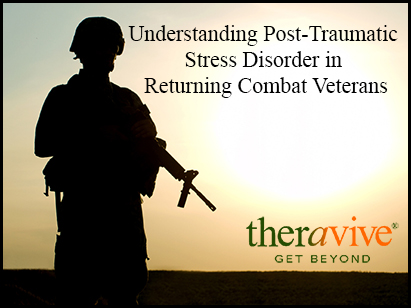 The United States is currently involved in a number of areas of the Middle East, particularly in Iraq and Afghanistan. There is increasing awareness among researchers and mental health professionals that there are a number of health and mental health problems that returning veterans are experiencing in their return from combat. Many returning veterans are presenting to medical professionals with emotional distress that is primarily being attributed to their experiences in these violent situations. Researchers are beginning to analyze what this means for this demographic, and how to best assist them in navigating the difficulties that they are experiencing.
The United States is currently involved in a number of areas of the Middle East, particularly in Iraq and Afghanistan. There is increasing awareness among researchers and mental health professionals that there are a number of health and mental health problems that returning veterans are experiencing in their return from combat. Many returning veterans are presenting to medical professionals with emotional distress that is primarily being attributed to their experiences in these violent situations. Researchers are beginning to analyze what this means for this demographic, and how to best assist them in navigating the difficulties that they are experiencing.
Post-traumatic Stress Disorder
Post-traumatic stress disorder was officially added to the DSM-III in 1980 after years of observing problems experienced by Vietnam war veterans (Sundin, et al., 2010). While PTSD is not limited to those who are exposed to combat; it is common in survivors of violent situations, accidents and abuse, and is one of the ways that researchers have come to understand the disorder. It is listed in the DSM as an anxiety disorder and the symptoms include flashbacks, nightmares, and frightening thoughts. It can also lead to avoidance symptoms such as staying out of certain situations, becoming numb, or forgetting the traumatic event. Some people may also experience sleep disturbance, anger outbursts and a constant feeling of tension.
Sundin et al. (2010) suggest that exposure to combat situations leads to an increased risk of Post-Traumatic Stress Disorder in returning military personnel. Previously, PTSD had been studied mainly in Vietnam war veterans as that was the last war in which hand to hand type of combat was prevalent. The first engagement in Iraq did not lead to as many problems for soldiers given the nature of operations that did not expose veterans to close combat situations (Pearrow and Cosgrove, 2009). In the current Iraq war, however, there is more guerrilla combat and surprise attacks on the ground by way of IED that lead to more traumatic experiences. This is showing itself in symptomology in returning veterans in obvious ways.
 Delayed Onset PTSD
Delayed Onset PTSD
Horesh, Soloman, Zerach, and Elin Dor (2011), explored the idea of delayed onset PTSD which occurs six months or more following the experience of the traumatic situation. This is thought to happen due to the fact that the initial homecoming while sometimes stressful is also a happy time that can mask symptoms. However, months later, stressful or negative events can occur that can contribute to or exacerbate PTSD symptoms. These researchers also found that there are factors that put veterans at a greater risk for PTSD. Among these are previous conditions prior to deployment, and more severe combat experiences. Additionally, according to Pearrow and Cosgrove (2009), younger soldiers and reservists are more likely to have severe PTSD symptoms. The latter is thought to be due to the fact that reservists are generally civilians who may not be as prepared to deal with the traumatic events that seem to be present in combat situations.
There are problems that seem to be common in combat exposed veterans upon returning home. These include high rates of domestic/partner violence, problems with sociability and increased anger outbursts (Pearrow and Cosgrove, 2009). Horesh, Soloman, Zerach and Elin Dor (2011), note that homecoming alone can be a stressful experience that can trigger PTSD symptoms as some veterans struggle to adjust back to civilian life. In some cases, they face divorce or unemployment that is difficult to deal with given the emotional trauma that they may concurrently be experiencing.
Returning Veterans
The U.S. Department of Veterans Affairs (2010), released a pamphlet for returning veterans that outlines what a soldier can expect to be feeling in relation to family, reintegration, and stressful events. They provide ideas on coping strategies that these individuals can use, and give resources for them should they find that they need additional help. It is important to remember that many returning veterans are reluctant to seek out help due to the fear of being stigmatized, so many go untreated (Sundin, et al. 2010).
Overall, there seems to be an increase in awareness among professionals and among family members about how PTSD could be affecting veterans so that interventions can be put into place more immediately when a problem is noted. This is a disorder that has implications not just for the combat veteran, but also for their partners, caregivers and children. As more and more return home, researchers and medical professionals need to explore successful ways to deal with what seems to be an increasing problem.
_________________________________________________________________________________________________________________________________
Horesh, D., Solomon, Z., Zerach, G., & Ein-dor, T. (2011). Delayed-onset PTSD among war veterans: The role of life events throughout the life cycle. Social Psychiatry and Psychiatric Epidemiology, 46(9), 863-70.
National Institute of Mental Health (n.d.). Post-traumatic stress disorder. Retrieved from http://www.nimh.nih.gov/health/publications/post-traumatic-stress-disorder-ptsd/index.shtml
Pearrow, M., & Cosgrove, L. (2009). The aftermath of combat-related PTSD. Communication Disorders Quarterly, 30(2), 77-82. doi:http://dx.doi.org/10.1177/1525740108328227
Sundin, J., Fear, N. T., Iversen, A., Rona, R. J., & Wessely, S. (2010). PTSD after deployment to Iraq: Conflicting rates, conflicting claims. Psychological Medicine, 40(3), 367-82
U.S. Department of Veteran Affairs (2010). Returning from the war zone: A guide for military personnel. Retrieved from http://www.ptsd.va.gov/public/reintegration/guide-pdf/SMGuide.pdf
About the Author
 Cathy England, MA
Cathy England, MACathy holds a Master’s degree in Psychology and has 13 years of work experience in counseling and social work. Cathy is an advocate for mental health awareness and enjoys educating people about mental health and the ways that it impacts people and communities. Most of her experience has been in work with court dependent or delinquent adolescents and their families. Cathy has also worked as a volunteer as a Court Appointed Special Advocate (CASA) for children under court supervision.
Professional Website:
crawfordcasa.org